We're so sad that we can't be in Italy to join Le Giornate del Cinema Muto in Pordenone this year. The 36th edition starts today and continues till 7 October. EFSP will do a festival post every day on one of the silent stars or the films than can be seen in Pordenone. We wish director Jay Weissberg good luck on his second edition which has a really delightful programme. Our series starts with a post on the closing event of the festival, Ernst Lubitsch's classic The Student Prince in Old Heidelberg (1927), featuring Ramón Novarro.
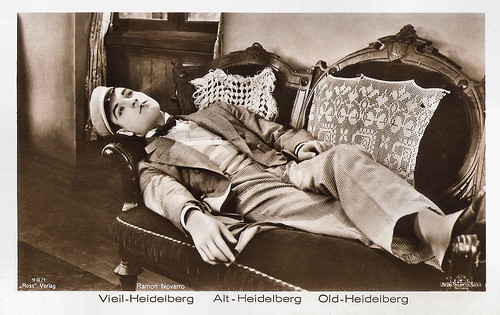
German postcard by Ross Verlag, no. 98/1. Photo: Metro-Goldwyn-Mayer. Publicity still for The Student Prince in Old Heidelberg (Ernst Lubitsch, 1927).

German postcard by Ross Verlag, no. 98/2. Photo: Metro-Goldwyn-Mayer. Publicity still for The Student Prince in Old Heidelberg (Ernst Lubitsch, 1927) with Ramon Novarro and Jean Hersholt.
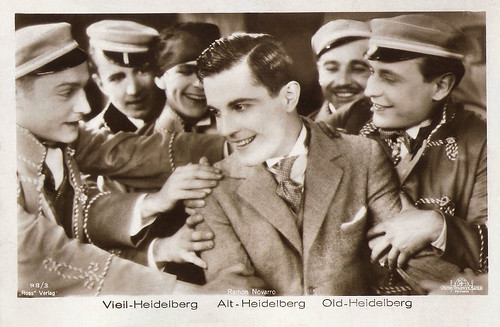
German postcard by Ross Verlag, no. 98/3. Photo: Metro-Goldwyn-Mayer. Publicity still for The Student Prince in Old Heidelberg (Ernst Lubitsch, 1927).
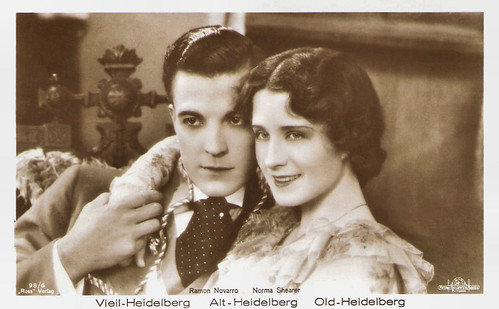
German postcard by Ross Verlag, no. 98/6. Photo: Metro-Goldwyn-Mayer. Publicity still for The Student Prince in Old Heidelberg (Ernst Lubitsch, 1927) with Ramon Novarro and Norma Shearer.
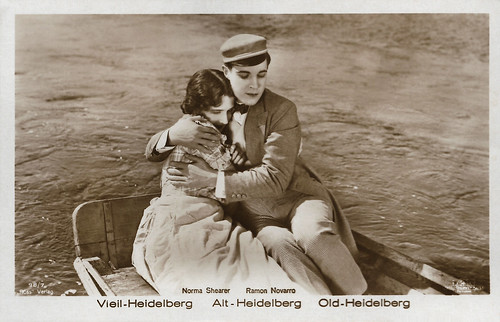
German postcard by Ross Verlag, no. 98/7. Photo: Metro-Goldwyn-Mayer. Publicity still for The Student Prince in Old Heidelberg (Ernst Lubitsch, 1927) with Ramon Novarro and Norma Shearer.
The American silent film The Student Prince in Old Heidelberg (1927), also known as The Student Prince, The Student Prince of Old Heidelberg and Old Heidelberg, is a Viennese fairy tale. The Metro-Goldwyn-Mayer production is based on the 1901 play Alt Heidelberg (Old Heidelberg) by Wilhelm Meyer-Förster. The script was written by Hanns Kräly and Karl Heinrich with titles by Marian Ainslee and Ruth Cummings.
MGM's executive producer Irving Thalberg initially planned to have Erich von Stroheim direct this film as a follow-up to the director's commercial success The Merry Widow. Stroheim declined, opting instead to leave MGM and begin work on The Wedding March (1928). Thalberg then tried to attach E.A. Dupont, and then John S. Robertson to the project, but both passed on it. He settled on thirty-four-year-old German émigré Ernst Lubitsch.
Wikipedia serves up the plot in detail: Young Crown Prince Karl Heinrich (Philippe De Lacy), heir to the kingdom of Karlsburg, is brought to live with his stern uncle, King Karl VII (Gustav von Seyffertitz). The king immediately dismisses the boy's nanny (Edythe Chapman) without telling the youngster to avoid an emotional farewell. Fortunately, Dr. Friedrich Jüttner (Jean Hersholt), his new tutor, proves to be sympathetic, and they become lifelong friends. Nonetheless, despite the commoners' belief that it must be wonderful to be him, the boy grows up lonely, without playmates his own age.
Upon passing his high school examination in 1901 with the help of Dr. Jüttner, the young prince (Ramon Novarro) is delighted to learn that both he and Jüttner are being sent to Heidelberg, where he will continue his education. When they arrive, Karl's servant is appalled at the rooms provided for the prince and Jüttner at the inn of Ruder (Otis Harlan). When Ruder's niece Kathi (Norma Shearer) stoutly defends the centuries-old family business, Karl is entranced by her, and decides to stay. He is quickly made a member of Corps Saxonia, a student society.
Later that day, Karl tries to kiss Kathi, only to learn that she is engaged. Her family approves of her fiance, but she is not so sure about him. She eventually confesses to Karl that, despite the vast social gulf between them, she has fallen in love with him. Karl feels the same about her and swears that he will let nothing separate them. When he takes her boating, their rower, Johann Kellermann (Bobby Mack), turns his back to them to give them some privacy. Karl jokingly tells him that, when he is king, he will make Kellermann his majordomo.
Then Jüttner receives a letter from the king ordering him to inform Karl that he has selected a princess for him to marry. Jüttner cannot bring himself to destroy his friend's happiness. That same day, however, Prime Minister von Haugk (Edward Connelly) arrives with the news that the king is seriously ill, and that Karl must go home and take up the reins of government. When Karl sees his uncle, he is told of the matrimonial plans. While Karl is still reeling from the shock, the old king dies, followed by Jüttner.
Later, von Haugk presses the new monarch about the marriage. The anguished Karl signs the document for the wedding. Then Kellermann shows up to take the job Karl had offered him. When Karl asks him about Kathi, he learns that she is still waiting for him. He goes to see her one last time. In the last scene, Karl is shown riding through the streets in a carriage with his bride, the princess. One onlooker remarks that it must be wonderful to be king, unaware of Karl's misery.
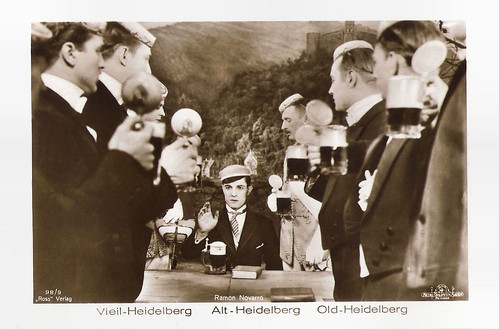
German postcard by Ross Verlag, no. 98/9. Photo: Metro-Goldwyn-Mayer. Publicity still for The Student Prince in Old Heidelberg (Ernst Lubitsch, 1927).
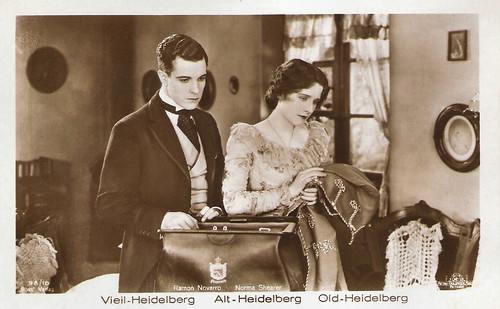
German postcard by Ross Verlag, no. 98/10. Photo: Metro-Goldwyn-Mayer. Publicity still for The Student Prince in Old Heidelberg (Ernst Lubitsch, 1927) with Ramon Novarro and Norma Shearer.
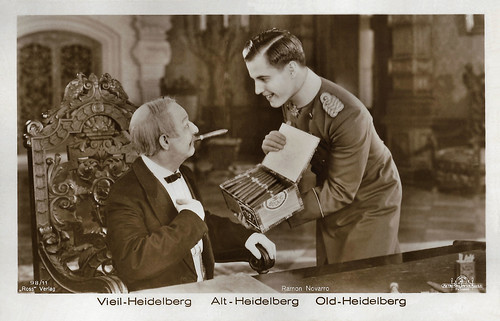
German postcard by Ross Verlag, no. 98/11. Photo: Metro-Goldwyn-Mayer. Publicity still for The Student Prince in Old Heidelberg (Ernst Lubitsch, 1927) with Ramon Novarro and Bobby Mack.
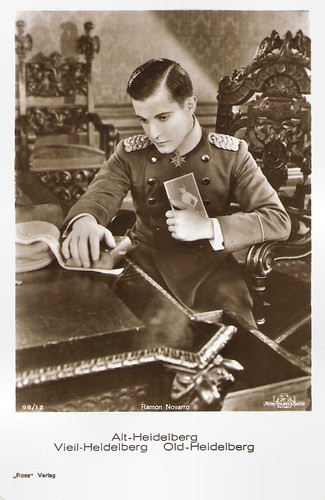
German postcard by Ross Verlag, no. 98/12. Photo: Metro-Goldwyn-Mayer. Publicity still for The Student Prince in Old Heidelberg (Ernst Lubitsch, 1927).
Ramon Novarro was cast as the Student Prince after John Gilbert was considered. Ernst Lubitsch felt that both Novarro and Shearer were miscast, but was unable to override the studio's casting decisions. According to Wikipedia, Lubitsch's insistence on multiple takes and minimal rehearsal time were hard on both leads. Shearer even complained to Thalberg, her fiance, about Lubitsch's penchant for acting out scenes for the actors before they were shot. Thalberg told her that "everyone has a lot to learn from Lubitsch."
The love scene in the beer garden, which is acclaimed as one of the best scenes in the film by modern critics, was allegedly a headache for the director, who had it reshot entirely, but was still unhappy with it. It was rumoured that the love scene in the film was reshot by John M. Stahl, but Lubitsch's assistant on the film, Andrew Marton, denied this.
The Student Prince in Old Heidelberg was in production for more than 108 days. The result is a supremely artificial and studio-built film, contrasting the voluminous sets of the Karlsburg Palace with the warmer interiors and exteriors of the Heidelberg taverns and beer gardens. Ernst Lubitsch drove up the budget significantly, infuriating the studio. For instance, he had costume designer Ali Hubert bring thirty-two trunks of wardrobe and props from Europe for use in the film.
Though now considered a classic, it was far from a unanimous critical success during its original theatrical run. In a review for The New York Times, Mordaunt Hall wrote, "Mr. Novarro is natural and earnest, but he is a little too Latin in appearance for the rôle. Norma Shearer is attractive as Kathi. She, however, does not seem to put her soul into the part. She, too, acts well, but, like Mr. Novarro, she does not respond, as other players have done, to Mr. Lubitsch's direction. The ablest acting in this piece of work is done by Jean Hersholt as Dr. Guttner (sic) and Gustav von Seyffertitz as the King. Their efforts in all their scenes reveal their sensitiveness to the direction."
Despite being a popular film with filmgoers, the exorbitant production cost of The Student Prince in Old Heidelberg (IMDb estimates it as $1.205.000) kept it from making a profit. The film lost $307,000, according to Wikipedia.
Today many viewers consider it one of Lubitsch's finest silent films. Adrian Banks at Senses of Cinema: "The Student Prince in Old Heidelberg is one of Lubitsch’s most surprising, nostalgic and emotionally engaging films. It represents a 'return to Germany' after four years in Hollywood, and can be seen as something of a watershed between his initial works for Warner Bros., then a significantly less important studio than it would soon become, and his extraordinary ten or so year tenure at Paramount."
Greg Carleton at IMDb: "I found this film an absolute delight. All of the leads put in outstanding performances. The romance between Prince Karl (Ramon Novarro) and Kathi (Norma Shearer) is wonderfully presented, and it is truly poignant." Ron Oliver at IMDb: "This wonderful, exuberant, heartbreaking film - one of the last major movies of the Silent Era - is a scintillating example of the artistry of director Ernst Lubitsch. Filled with wry humor & aching pathos, Lubitsch tells a tale which is a persuasive paean to the power of the talkless film." We totally agree.

German postcard by Ross Verlag, no. 3608/1, 1928-1929. Photo: Metro-Goldwyn-Mayer. Novarro wears the outfit of The Student Prince in Old Heidelberg (Ernst Lubitsch, 1927) at the end of the film (though it may have been recycled for a later film, as the Ross number suggests).
Trailer The Student Prince in Old Heidelberg (1927). Source: TV Movie Trailer (Daily Motion).
Sources: Adrian Banks (Senses of Cinema), Greg Carleton (IMDb), Ron Oliver (IMDb), Wikipedia and IMDb.

German postcard by Ross Verlag, no. 98/1. Photo: Metro-Goldwyn-Mayer. Publicity still for The Student Prince in Old Heidelberg (Ernst Lubitsch, 1927).

German postcard by Ross Verlag, no. 98/2. Photo: Metro-Goldwyn-Mayer. Publicity still for The Student Prince in Old Heidelberg (Ernst Lubitsch, 1927) with Ramon Novarro and Jean Hersholt.

German postcard by Ross Verlag, no. 98/3. Photo: Metro-Goldwyn-Mayer. Publicity still for The Student Prince in Old Heidelberg (Ernst Lubitsch, 1927).

German postcard by Ross Verlag, no. 98/6. Photo: Metro-Goldwyn-Mayer. Publicity still for The Student Prince in Old Heidelberg (Ernst Lubitsch, 1927) with Ramon Novarro and Norma Shearer.

German postcard by Ross Verlag, no. 98/7. Photo: Metro-Goldwyn-Mayer. Publicity still for The Student Prince in Old Heidelberg (Ernst Lubitsch, 1927) with Ramon Novarro and Norma Shearer.
A Viennese fairy tale
The American silent film The Student Prince in Old Heidelberg (1927), also known as The Student Prince, The Student Prince of Old Heidelberg and Old Heidelberg, is a Viennese fairy tale. The Metro-Goldwyn-Mayer production is based on the 1901 play Alt Heidelberg (Old Heidelberg) by Wilhelm Meyer-Förster. The script was written by Hanns Kräly and Karl Heinrich with titles by Marian Ainslee and Ruth Cummings.
MGM's executive producer Irving Thalberg initially planned to have Erich von Stroheim direct this film as a follow-up to the director's commercial success The Merry Widow. Stroheim declined, opting instead to leave MGM and begin work on The Wedding March (1928). Thalberg then tried to attach E.A. Dupont, and then John S. Robertson to the project, but both passed on it. He settled on thirty-four-year-old German émigré Ernst Lubitsch.
Wikipedia serves up the plot in detail: Young Crown Prince Karl Heinrich (Philippe De Lacy), heir to the kingdom of Karlsburg, is brought to live with his stern uncle, King Karl VII (Gustav von Seyffertitz). The king immediately dismisses the boy's nanny (Edythe Chapman) without telling the youngster to avoid an emotional farewell. Fortunately, Dr. Friedrich Jüttner (Jean Hersholt), his new tutor, proves to be sympathetic, and they become lifelong friends. Nonetheless, despite the commoners' belief that it must be wonderful to be him, the boy grows up lonely, without playmates his own age.
Upon passing his high school examination in 1901 with the help of Dr. Jüttner, the young prince (Ramon Novarro) is delighted to learn that both he and Jüttner are being sent to Heidelberg, where he will continue his education. When they arrive, Karl's servant is appalled at the rooms provided for the prince and Jüttner at the inn of Ruder (Otis Harlan). When Ruder's niece Kathi (Norma Shearer) stoutly defends the centuries-old family business, Karl is entranced by her, and decides to stay. He is quickly made a member of Corps Saxonia, a student society.
Later that day, Karl tries to kiss Kathi, only to learn that she is engaged. Her family approves of her fiance, but she is not so sure about him. She eventually confesses to Karl that, despite the vast social gulf between them, she has fallen in love with him. Karl feels the same about her and swears that he will let nothing separate them. When he takes her boating, their rower, Johann Kellermann (Bobby Mack), turns his back to them to give them some privacy. Karl jokingly tells him that, when he is king, he will make Kellermann his majordomo.
Then Jüttner receives a letter from the king ordering him to inform Karl that he has selected a princess for him to marry. Jüttner cannot bring himself to destroy his friend's happiness. That same day, however, Prime Minister von Haugk (Edward Connelly) arrives with the news that the king is seriously ill, and that Karl must go home and take up the reins of government. When Karl sees his uncle, he is told of the matrimonial plans. While Karl is still reeling from the shock, the old king dies, followed by Jüttner.
Later, von Haugk presses the new monarch about the marriage. The anguished Karl signs the document for the wedding. Then Kellermann shows up to take the job Karl had offered him. When Karl asks him about Kathi, he learns that she is still waiting for him. He goes to see her one last time. In the last scene, Karl is shown riding through the streets in a carriage with his bride, the princess. One onlooker remarks that it must be wonderful to be king, unaware of Karl's misery.

German postcard by Ross Verlag, no. 98/9. Photo: Metro-Goldwyn-Mayer. Publicity still for The Student Prince in Old Heidelberg (Ernst Lubitsch, 1927).

German postcard by Ross Verlag, no. 98/10. Photo: Metro-Goldwyn-Mayer. Publicity still for The Student Prince in Old Heidelberg (Ernst Lubitsch, 1927) with Ramon Novarro and Norma Shearer.

German postcard by Ross Verlag, no. 98/11. Photo: Metro-Goldwyn-Mayer. Publicity still for The Student Prince in Old Heidelberg (Ernst Lubitsch, 1927) with Ramon Novarro and Bobby Mack.

German postcard by Ross Verlag, no. 98/12. Photo: Metro-Goldwyn-Mayer. Publicity still for The Student Prince in Old Heidelberg (Ernst Lubitsch, 1927).
A scintillating example of the artistry of Ernst Lubitsch
Ramon Novarro was cast as the Student Prince after John Gilbert was considered. Ernst Lubitsch felt that both Novarro and Shearer were miscast, but was unable to override the studio's casting decisions. According to Wikipedia, Lubitsch's insistence on multiple takes and minimal rehearsal time were hard on both leads. Shearer even complained to Thalberg, her fiance, about Lubitsch's penchant for acting out scenes for the actors before they were shot. Thalberg told her that "everyone has a lot to learn from Lubitsch."
The love scene in the beer garden, which is acclaimed as one of the best scenes in the film by modern critics, was allegedly a headache for the director, who had it reshot entirely, but was still unhappy with it. It was rumoured that the love scene in the film was reshot by John M. Stahl, but Lubitsch's assistant on the film, Andrew Marton, denied this.
The Student Prince in Old Heidelberg was in production for more than 108 days. The result is a supremely artificial and studio-built film, contrasting the voluminous sets of the Karlsburg Palace with the warmer interiors and exteriors of the Heidelberg taverns and beer gardens. Ernst Lubitsch drove up the budget significantly, infuriating the studio. For instance, he had costume designer Ali Hubert bring thirty-two trunks of wardrobe and props from Europe for use in the film.
Though now considered a classic, it was far from a unanimous critical success during its original theatrical run. In a review for The New York Times, Mordaunt Hall wrote, "Mr. Novarro is natural and earnest, but he is a little too Latin in appearance for the rôle. Norma Shearer is attractive as Kathi. She, however, does not seem to put her soul into the part. She, too, acts well, but, like Mr. Novarro, she does not respond, as other players have done, to Mr. Lubitsch's direction. The ablest acting in this piece of work is done by Jean Hersholt as Dr. Guttner (sic) and Gustav von Seyffertitz as the King. Their efforts in all their scenes reveal their sensitiveness to the direction."
Despite being a popular film with filmgoers, the exorbitant production cost of The Student Prince in Old Heidelberg (IMDb estimates it as $1.205.000) kept it from making a profit. The film lost $307,000, according to Wikipedia.
Today many viewers consider it one of Lubitsch's finest silent films. Adrian Banks at Senses of Cinema: "The Student Prince in Old Heidelberg is one of Lubitsch’s most surprising, nostalgic and emotionally engaging films. It represents a 'return to Germany' after four years in Hollywood, and can be seen as something of a watershed between his initial works for Warner Bros., then a significantly less important studio than it would soon become, and his extraordinary ten or so year tenure at Paramount."
Greg Carleton at IMDb: "I found this film an absolute delight. All of the leads put in outstanding performances. The romance between Prince Karl (Ramon Novarro) and Kathi (Norma Shearer) is wonderfully presented, and it is truly poignant." Ron Oliver at IMDb: "This wonderful, exuberant, heartbreaking film - one of the last major movies of the Silent Era - is a scintillating example of the artistry of director Ernst Lubitsch. Filled with wry humor & aching pathos, Lubitsch tells a tale which is a persuasive paean to the power of the talkless film." We totally agree.

German postcard by Ross Verlag, no. 3608/1, 1928-1929. Photo: Metro-Goldwyn-Mayer. Novarro wears the outfit of The Student Prince in Old Heidelberg (Ernst Lubitsch, 1927) at the end of the film (though it may have been recycled for a later film, as the Ross number suggests).
Trailer The Student Prince in Old Heidelberg (1927). Source: TV Movie Trailer (Daily Motion).
Sources: Adrian Banks (Senses of Cinema), Greg Carleton (IMDb), Ron Oliver (IMDb), Wikipedia and IMDb.
No comments:
Post a Comment